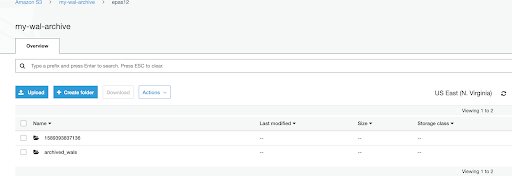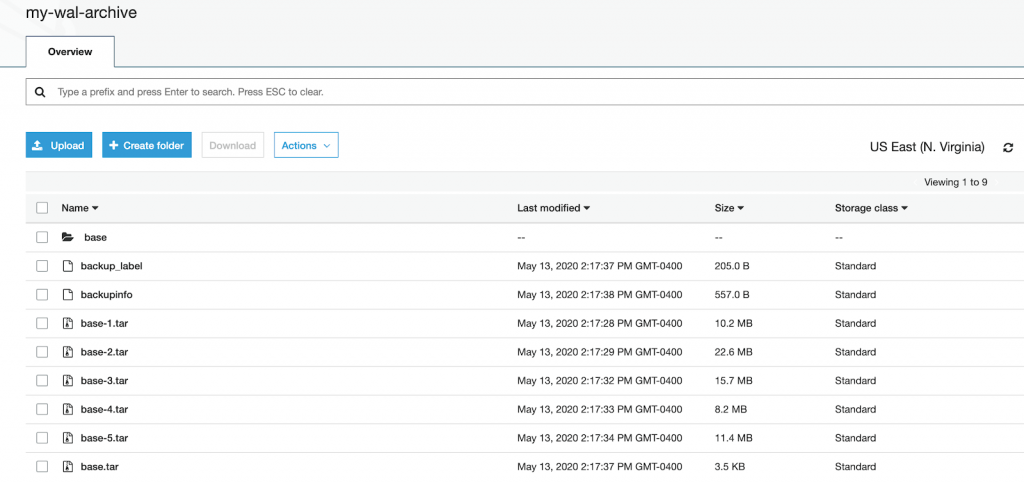Abstract
This article provides step-by-step instructions for using the EDB Postgres Backup and Recovery Tool (BART) to save PostgreSQL backups to Amazon AWS S3.
Step 1: Install BART on master and standby servers
Step 2: Install and configure S3FS-FUSE on master and standby servers
Step 3: Configure BART on master and standby servers
Step 4: Test BART configuration on master and standby servers
Step 5: Verify that backup and archived WAL files are stored in S3 (optional)
EDB Postgres Backup and Recovery Tool (BART) allows users to configure and schedule backups, apply backup retention policies, and restore databases to a point in time using simple commands. Using BART, users can schedule full weekly and daily incremental backups of their PostgreSQL and EDB Postgres Advanced Server databases.
There are many customers who want to store their backups on cloud storage solutions like AWS S3 and would like BART to store backups on S3 storage. Since BART doesn’t have direct integration with AWS S3, there are alternatives such as mounting S3 storage as NFS onto the BART host and taking backup. AWS Storage Gateway is one option, but there are other solutions available, such as ObjectiveFS (commercial) and S3FS-FUSE (free open source), which can be used to mount S3 storage to servers, if you don’t want to pay for an AWS Storage Gateway server.
In this post, I have used the open source S3FS-FUSE solution to show how it can be used to mount S3 storage on the BART/DB host for storing backups on S3.
In my setup, I am running a master and two standby servers using Postgres streaming replication and monitored by EDB Failover Manager (EFM). The virtual IP (VIP) is assigned to the master server. The VIP can be replaced by the physical IP address of the database server, in case streaming replication is not set up.
Here is my setup:
[root@localhost etc]# /usr/edb/efm-3.9/bin/efm cluster-status efm
Cluster Status: efm
Agent Type Address Agent DB VIP
-----------------------------------------------------------------------
Standby xxx.xx.xx.55 UP UP xxx.xx.xx.150
Master xxx.xx.xx.59 UP UP xxx.xx.xx.150*
Standby xxx.xx.xx.60 UP UP xxx.xx.xx.150
Allowed node host list:
xxx.xx.xx.55 xxx.xx.xx.59 xxx.xx.xx.60
Membership coordinator:
xxx.xx.xx.60
Standby priority host list:
xxx.xx.xx.55 xxx.xx.xx.60
Promote Status:
DB Type Address WAL Received LSN WAL Replayed LSN Info
---------------------------------------------------------------------------
Master xxx.xx.xx.59 0/AED01D0
Standby xxx.xx.xx.55 0/AED01D0 0/AED01D0
Standby xxx.xx.xx.60 0/AED01D0 0/AED01D0
Standby database(s) in sync with master. It is safe to promote.
Step 1: Install BART on master and standby servers
As root:
yum install edb-bart
Create bart user and group:
[root@localhost ~]# groupadd bart
[root@localhost ~]# useradd bart -g bart
[root@localhost ~]# id bart
uid=1004(bart) gid=1004(bart) groups=1004(bart)
Create a backup directory:
mkdir -p /opt/backup
Change ownership:
chown bart:bart /opt/backup
Add bart command to PATH in .bash_profile for bar user:
su – bart
vi .bash_profile
export PATH=$PATH:/usr/edb/bart/bin
Save the file.
Step 2: Install and configure S3FS-FUSE on master and standby servers
As root:
yum install s3fs-fuse
Store your S3 access key and secret key in ~/.passwd-s3fs file:
echo “<ACCESSKEY>:<SECRETKEY>” > ~/.passwd-s3fs
chmod 0600 ~/.passwd-s3fs
Mount your S3 bucket to /opt/backup file system.
Add the following entry in /etc/fstab:
s3fs#my-wal-archive /opt/backup fuse
_netdev,rw,nosuid,nodev,allow_other,nonempty 0 0
Run the following command to mount the directory:
mount -a
Step 3: Configure BART on master and standby servers
As root:
cd /usr/edb/bart/etc
cp bart.cfg.sample bart.cfg
Add/update following sections:
[BART]
bart_host= bart@xxx.xx.xx.150
backup_path = /opt/backup
pg_basebackup_path = /usr/edb/as12/bin/pg_basebackup
logfile = /tmp/bart.log
scanner_logfile = /tmp/bart_scanner.log
thread_count = 5
[EPAS12]
host = xxx.xx.xx.150
port = 5444
user = repuser
cluster_owner = enterprisedb
description = "EPAS 12 Server"
allow_incremental_backups = enabled
Save bart.cfg.
As enterprisedb user, create a replication user:
-bash-4.2$ /usr/edb/as12/bin/psql -h xxx.xx.xx.150 -p 5444 edb
Password for user enterprisedb:
psql (12.2.3)
Type "help" for help.
edb=# CREATE ROLE repuser WITH LOGIN SUPERUSER PASSWORD 'repuser';
CREATE ROLE
Modify pg_hba.conf and add entry for replication database user:
host replication repuser xxx.xx.xx.0/24 md5
Reload conf:
-bash-4.2$ /usr/edb/as12/bin/pg_ctl reload -D /var/lib/edb/as12/data
server signaled
Add .pgpass entry in bart user’s home directory:
su - bart
vi ~/.pgpass
xxx.xx.xx.150:5444:*:repuser:repuser
chmod 0600 ~/.pgpass
Setup a password-less ssh connection.
As root:
vi /etc/ssh/sshd_config
Set PubkeyAuthentication to yes
Reload sshd service:
systemctl reload sshd
su – bart
ssh-keygen -t rsa
cd .ssh
cat id_rsa.pub > authorized_keys
chmod 0600 authorized_keys
scp the id_rsa.pub from other servers and append it to authorized_keys:
e.g.:
scp root@xxx.xx.xx.59:/home/bart/.ssh/id_rsa.pub /tmp/bart.pub
cat /tmp/bart.pub >> authorized_keys
Generate the ssh keys for enterprisedb user and append it to authorized_keys for bart user:
su – enterprisedb
ssh-keygen -t rsa
cd .ssh
cp id_rsa.pub /tmp/enterprisedb.pub
su – bart
cd .ssh
cat /tmp/enterprisedb.pub >> authorized_keys
Make sure to scp enterprisedb ssh keys from other servers and append it to bart user’s authorized_keys.
Repeat the process on all servers where BART is installed.
Test to make sure you are able to do password-less ssh connections to other servers using bart user:
su - bart
ssh bart@xxx.xx.xx.55
su – enterprisedb
ssh bart@xxx.xx.xx.55
Step 4: Test BART configuration on master and standby servers
su - bart
bart check-config
INFO: Verifying that pg_basebackup is executable
INFO: success - pg_basebackup(/usr/edb/as12/bin/pg_basebackup) returns version 12.200000
bart show-servers -s epas12
SERVER NAME : epas12
HOST NAME : xxx.xx.xx.150
USER NAME : repuser
PORT : 5444
REMOTE HOST :
RETENTION POLICY : none
DISK UTILIZATION : 0.00 bytes
NUMBER OF ARCHIVES : 0
ARCHIVE PATH : /opt/backup/epas12/archived_wals
ARCHIVE COMMAND : (disabled)
XLOG METHOD : fetch
WAL COMPRESSION : disabled
TABLESPACE PATH(s) :
INCREMENTAL BACKUP : ENABLED
DESCRIPTION : "EPAS 12 Server"
[bart@localhost ~]$ bart backup -s epas12
INFO: DebugTarget - getVar(checkDiskSpace.bytesAvailable)
INFO: new backup identifier generated 1589393837136
INFO: creating 5 harvester threads
NOTICE: WAL archiving is not enabled; you must ensure that all required WAL segments are copied through other means to complete the backup
INFO: backup completed successfully
INFO:
BART VERSION: 2.5.3
BACKUP DETAILS:
BACKUP STATUS: active
BACKUP IDENTIFIER: 1589393837136
BACKUP NAME: none
BACKUP PARENT: none
BACKUP LOCATION: /opt/backup/epas12/1589393837136
BACKUP SIZE: 68.05 MB
BACKUP FORMAT: tar
BACKUP TIMEZONE: America/New_York
XLOG METHOD: fetch
BACKUP CHECKSUM(s): 0
TABLESPACE(s): 0
START WAL LOCATION: 0000000E000000000000000B
BACKUP METHOD: streamed
BACKUP FROM: master
START TIME: 2020-05-13 14:17:17 EDT
STOP TIME: 2020-05-13 14:17:36 EDT
TOTAL DURATION: 19 sec(s)
[bart@localhost ~]$ bart show-backups
SERVER NAME BACKUP ID BACKUP NAME BACKUP PARENT BACKUP TIME BACKUP SIZE WAL(s) SIZE WAL FILES STATUS
epas12 1589393837136 none none 2020-05-13 14:17:36 EDT 68.05 MB 0.00 bytes 0 active
[bart@localhost ~]$ cd /opt/backup
[bart@localhost backup]$ cd eaps12
-bash: cd: eaps12: No such file or directory
[bart@localhost backup]$ ls
basebackups_005 epas10 epas11 epas12 wal_005
[bart@localhost backup]$ cd epas12
[bart@localhost epas12]$ ls
1589393837136 archived_wals
[bart@localhost epas12]$ ls -l
total 1
drwxrwxr-x. 1 bart bart 0 May 13 14:17 1589393837136
drwxrwxr-x. 1 bart bart 0 May 13 12:48 archived_wals
[bart@localhost epas12]$ cd 1589393837136/
[bart@localhost 1589393837136]$ ls -l
total 69691
-rw-rw-r--. 1 bart bart 557 May 13 14:17 backupinfo
-rw-rw-r--. 1 bart bart 205 May 13 14:17 backup_label
drwxrwxr-x. 1 bart bart 0 May 13 14:17 base
-rw-rw-r--. 1 bart bart 10655232 May 13 14:17 base-1.tar
-rw-rw-r--. 1 bart bart 23749120 May 13 14:17 base-2.tar
-rw-rw-r--. 1 bart bart 16449024 May 13 14:17 base-3.tar
-rw-rw-r--. 1 bart bart 8587264 May 13 14:17 base-4.tar
-rw-rw-r--. 1 bart bart 11913728 May 13 14:17 base-5.tar
-rw-rw-r--. 1 bart bart 3584 May 13 14:17 base.tar
Step 5: Verify that backup and archived WAL files are stored in S3 (optional)
Please note that archived wals will only be stored in S3 if you have set up archiving and archived command in postgresql.conf. Please follow instructions from the BART guide.


